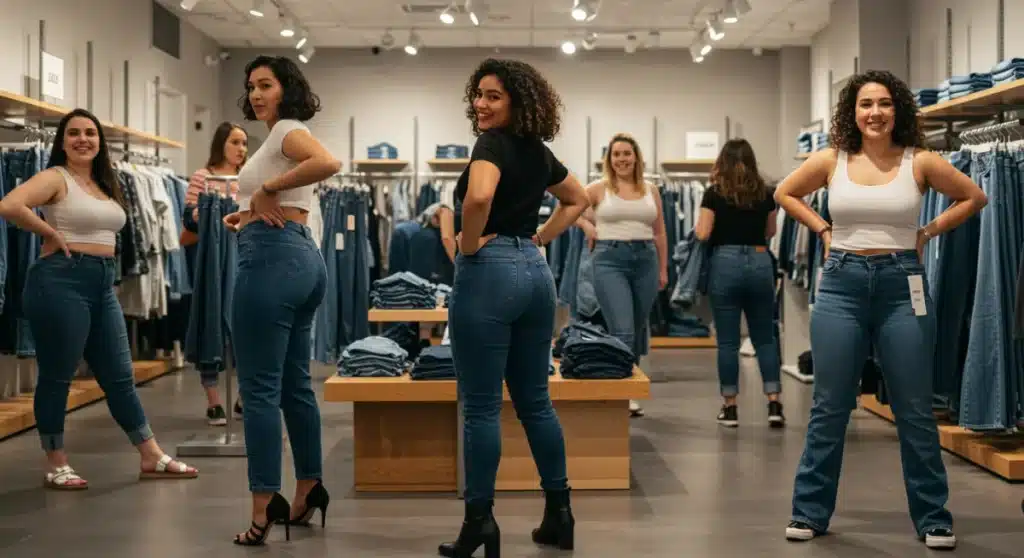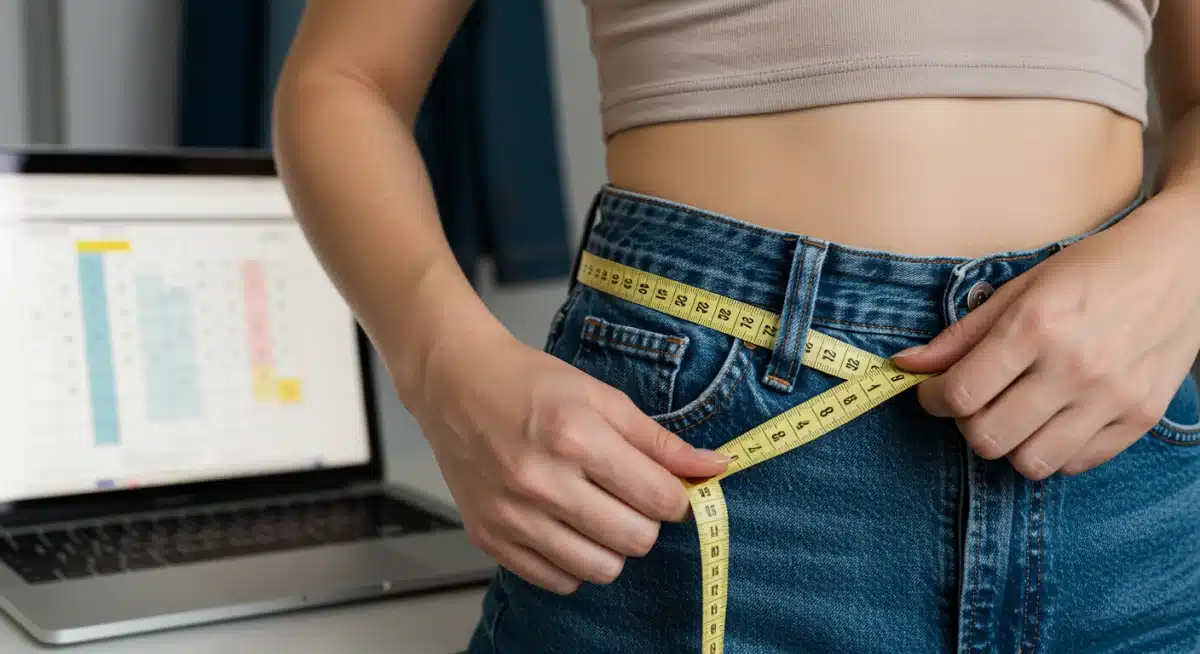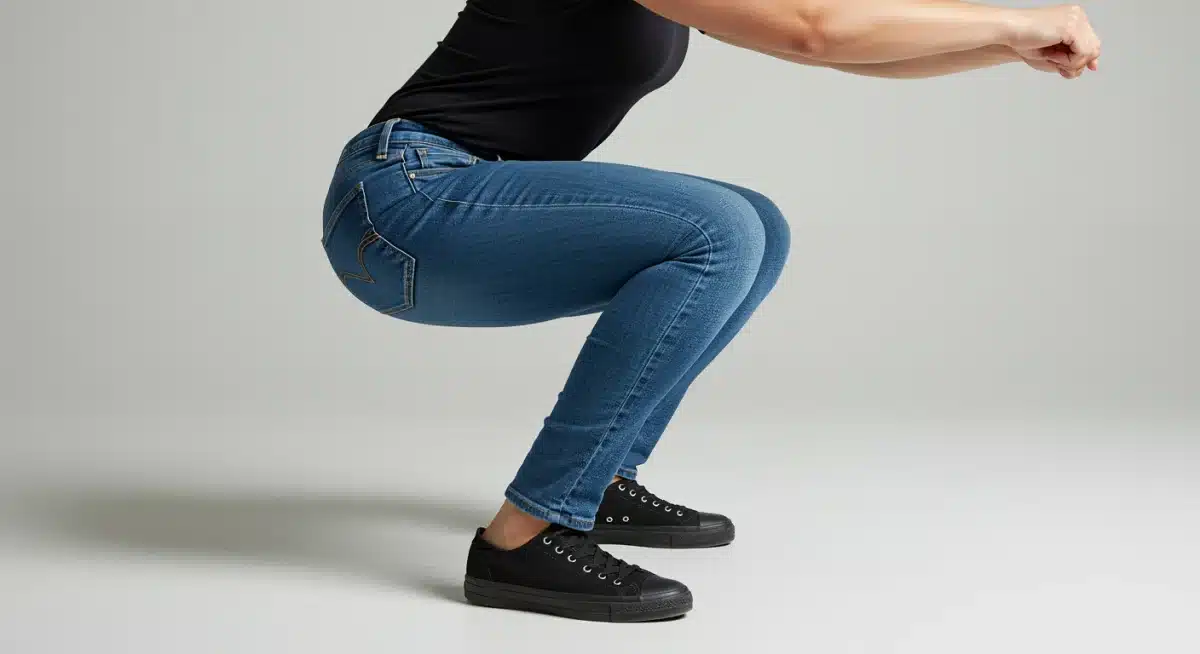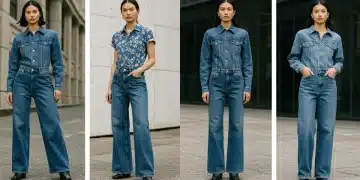Find Your Perfect Jeans Fit 2025: Online & In-Store Guide

Advertisement
Finding the perfect jeans fit involves understanding your body measurements, recognizing different denim styles, and utilizing smart shopping strategies both online and in-store to achieve comfort and style.
Are you tired of the endless quest for jeans that truly fit? In 2025, finding the perfect jeans fit is more accessible than ever, thanks to advancements in online shopping tools and personalized in-store experiences. This comprehensive guide will navigate you through the evolving landscape of denim, ensuring you discover jeans that not only look great but feel incredibly comfortable, whether you’re clicking ‘add to cart’ or stepping into a fitting room.
Understanding Your Body Type: The Foundation of a Great Fit
Before you even begin to browse, understanding your unique body shape is paramount. Jeans are designed to complement, not conceal, your natural silhouette. Knowing your body type helps narrow down the vast array of styles and cuts, making your search significantly more efficient and enjoyable.
Advertisement
There are generally five main body types, each with specific characteristics that certain jean styles can flatter. Identifying yours is the first crucial step toward denim enlightenment.
The Five Main Body Types and Their Ideal Jeans
Each body type has characteristics that lend themselves to particular jean cuts. Experimentation is key, but these guidelines offer a solid starting point.
- Pear Shape: Characterized by wider hips and thighs, and a narrower bust. Look for bootcut, flare, or straight-leg jeans that balance your proportions. High-waisted styles can also be very flattering.
- Apple Shape: Typically carries weight around the midsection with narrower hips and legs. Straight-leg, bootcut, or relaxed-fit jeans are often ideal. Mid-rise or high-rise jeans can provide comfortable coverage.
- Rectangle Shape: Shoulders, waist, and hips are roughly the same width, creating a straight silhouette. Skinny, straight-leg, or boyfriend jeans can add curves. Details like whiskering or pocket placements can also enhance shape.
- Hourglass Shape: Defined by a well-proportioned bust and hips with a narrow waist. Embrace high-waisted, skinny, or bootcut jeans that highlight your curves. Stretch denim is often a good choice.
- Inverted Triangle Shape: Broader shoulders and bust with narrower hips. Opt for bootcut, flare, or wide-leg jeans to balance your upper body. Low-rise styles can also be a good option.
Once you’ve identified your body type, you can approach the denim market with a clearer vision. This foundational knowledge empowers you to make informed decisions, whether you’re sifting through racks in a store or scrolling through online catalogs.
Advertisement
Mastering Measurements: Your Secret Weapon for Online and In-Store Success
Accurate measurements are the bedrock of finding well-fitting jeans, especially when shopping online. Don’t rely solely on the size you usually wear, as sizing can vary significantly between brands. Take the time to measure yourself properly at home.
You’ll need a flexible tape measure and a mirror. It’s best to measure over light clothing or directly against your skin for the most accurate results.
Key Measurements for Jeans
Understanding where and how to measure is crucial. These three measurements are the most important for denim:
- Waist: Measure around the narrowest part of your natural waistline, usually just above your belly button. Don’t pull the tape too tight.
- Hips: Measure around the fullest part of your hips and glutes, ensuring the tape is level all the way around.
- Inseam: Measure from the top of your inner thigh (crotch area) down to where you want the hem of your jeans to fall. Consider if you’ll be wearing heels or flats.
Additionally, some brands provide thigh measurements, which can be useful, especially for those with athletic builds or larger thighs. Always compare your measurements to the brand’s specific size chart, as these can differ greatly from one manufacturer to another. This diligent approach to measurement significantly reduces the guesswork and the likelihood of returns, making your overall shopping experience much smoother.

Decoding Denim Styles: From Skinny to Wide-Leg
The world of denim styles is vast and ever-evolving. Staying current with popular cuts and understanding how they differ is essential for making an informed choice. Each style offers a distinct silhouette and feel, catering to different preferences and occasions.
In 2025, while classic styles endure, new interpretations and a strong emphasis on comfort and versatility are evident.
Popular Jeans Styles in 2025
Knowing the characteristics of each style will help you articulate what you’re looking for, whether to a sales associate or an online search engine.
- Skinny Jeans: Remain a staple, offering a form-fitting silhouette from waist to ankle. Ideal for showcasing footwear and creating a sleek look.
- Straight-Leg Jeans: A timeless classic, providing a consistent width from the hip down to the ankle. Versatile and flattering for many body types.
- Bootcut Jeans: Fitted through the thigh and slightly flared from the knee down, designed to accommodate boots. They offer a balanced silhouette.
- Flare Jeans: Similar to bootcut but with a more dramatic flare below the knee. A nod to retro styles, offering a bold fashion statement.
- Wide-Leg Jeans: Relaxed fit throughout the leg, widening from the hip or thigh down to the hem. Prioritize comfort and a flowy aesthetic.
- Mom Jeans/Dad Jeans: High-waisted with a relaxed fit through the hip and thigh, often tapering at the ankle. Offers a vintage, comfortable vibe.
- Boyfriend/Girlfriend Jeans: Designed for a relaxed, slightly oversized fit, often cuffed at the ankle. Boyfriend jeans are looser, while girlfriend jeans are a bit more tailored.
Beyond the cut, consider the rise – low, mid, or high. High-rise jeans continue to be popular for their figure-flattering and comfortable waist placement. Mid-rise offers a classic, versatile option, while low-rise is making a subtle comeback for specific fashion statements. The fabric composition, including stretch content, also plays a significant role in comfort and fit.
The Art of Online Jeans Shopping: Tips for Digital Success
Shopping for jeans online offers unparalleled convenience and selection, but it also comes with its challenges. Without the ability to try them on, you need a strategic approach to ensure satisfaction. The key lies in thorough research and leveraging available digital tools.
Many brands are investing in advanced online fitting tools and detailed product descriptions to enhance the virtual shopping experience.
Maximizing Your Online Denim Purchase
To minimize returns and find your ideal pair, follow these steps:
- Consult Size Charts: Always, always refer to the specific brand’s size chart. Don’t assume your usual size will translate.
- Read Reviews: Pay close attention to customer reviews, especially those mentioning fit, stretch, and how true-to-size the jeans are. Look for reviews from people with similar body types to yours.
- Utilize Virtual Try-On Tools: Many retailers now offer augmented reality (AR) try-on features or questionnaires that suggest sizes based on your input. While not perfect, they can provide valuable guidance.
- Understand Fabric Composition: Note the percentage of cotton, polyester, elastane, etc. This affects stretch, drape, and how the jeans will wear over time. Higher elastane content means more stretch and often a more forgiving fit.
- Check Return Policies: Before committing, understand the return policy. Free returns are a huge plus when buying denim online.
Don’t be afraid to order multiple sizes if a brand’s sizing is inconsistent or you’re between sizes. This allows you to try them on at home and send back what doesn’t fit, replicating a bit of the in-store experience. Online shopping, when done strategically, can be incredibly rewarding, opening up a world of denim options.
In-Store Shopping: The Hands-On Approach to Finding Your Fit
Despite the rise of e-commerce, the in-store experience remains invaluable for finding the perfect jeans fit. Being able to physically touch the fabric, see the color in person, and try on multiple pairs immediately can make all the difference. This hands-on approach allows for instant feedback and personalized assistance.
Leverage the expertise of sales associates and the convenience of fitting rooms to your advantage.
Tips for a Successful In-Store Denim Hunt
Make the most of your trip to the denim section with these practical strategies:
- Wear Appropriate Undergarments: Choose underwear that you would typically wear with jeans to get an accurate sense of the fit.
- Bring Shoes: If you plan to wear your new jeans with specific shoes (e.g., heels, sneakers, boots), bring them to the store to check the hem length and overall look.
- Try Different Sizes: Even if you know your measurements, grab a size up and a size down from your usual. Sizing can vary, and you might be surprised by what fits best.
- Move Around in the Fitting Room: Don’t just stand there. Sit down, squat, walk around, and bend your knees. This helps assess comfort and flexibility. If they pinch or restrict movement, they’re not the right fit.
- Ask for Assistance: Sales associates can be a wealth of knowledge. They can suggest styles you might not have considered and offer insights into how different fabrics stretch or relax.
The tactile experience of in-store shopping allows for a more comprehensive evaluation of comfort, material, and how the jeans move with your body. It’s an opportunity to ensure that the jeans don’t just look good but also feel good, supporting your daily activities without compromise.

Beyond the Basic Fit: Fabric, Stretch, and Details
Once you’ve considered body type and measurements, delving into fabric composition, stretch, and design details can elevate your jeans selection from good to exceptional. These elements significantly impact comfort, durability, and overall aesthetic.
Modern denim blends offer a range of properties, from rigid vintage-inspired styles to ultra-stretchy options that move with you.
The Nuances of Denim Selection
Understanding these finer points will help you choose jeans that truly meet your expectations:
- Fabric Composition:
- 100% Cotton: Offers a classic, rigid denim feel that molds to your body over time. Less stretch, more structure.
- Cotton Blends (with Elastane/Spandex/Lycra): Provides stretch and comfort, allowing for greater freedom of movement and a more forgiving fit. Ideal for skinny and slim styles.
- Sustainable Fabrics: Look for organic cotton, recycled denim, or blends with Tencel/Lyocell for eco-friendlier options.
- Wash and Finish: The wash (e.g., dark, light, distressed) and finish (e.g., whiskering, fading, rips) dramatically alter the look and feel of jeans. Dark washes are generally more formal, while lighter washes and distressed finishes lend a casual vibe.
- Pocket Placement and Size: Rear pockets can significantly impact the appearance of your derriere. Higher, smaller pockets can create a lifting effect, while larger, lower pockets might flatten.
- Hardware: Zippers, buttons, and rivets contribute to the overall quality and aesthetic. Good quality hardware is a sign of a well-made pair of jeans.
Consider the occasion for which you’re buying the jeans. A rigid, dark-wash pair might be perfect for a smart-casual office environment, while a stretchy, distressed pair is ideal for weekend casual. Paying attention to these details ensures your jeans are not just a good fit, but also a perfect match for your lifestyle and personal style.
Maintaining Your Perfect Fit: Care and Longevity
Finding the perfect pair of jeans is only half the battle; maintaining that fit and prolonging their lifespan is equally important. Proper care can prevent shrinkage, stretching, and fading, ensuring your beloved denim remains a staple in your wardrobe for years to come.
Denim, by nature, is a durable fabric, but it benefits from mindful washing and storage practices.
Best Practices for Denim Care
Extend the life and preserve the fit of your jeans with these simple yet effective tips:
- Wash Less Frequently: Jeans don’t need to be washed after every wear. Spot clean small stains. Washing less often helps preserve the fabric, color, and fit.
- Wash Cold and Inside Out: Always wash jeans in cold water to prevent shrinking and fading. Turning them inside out protects the outer surface and any special finishes.
- Use a Gentle Cycle: A gentle cycle minimizes wear and tear on the fabric. Avoid harsh detergents.
- Air Dry: The dryer is denim’s enemy. High heat can cause shrinkage, damage elastic fibers, and fade color. Air dry your jeans by laying them flat or hanging them to maintain their shape and integrity.
- Store Properly: Fold or hang your jeans neatly to prevent unnecessary creasing or stretching out of shape.
For raw denim or very dark washes, consider an initial soak to set the dye and minimize bleeding. Over time, denim will naturally relax and conform to your body, creating a personalized fit that’s truly unique to you. By integrating these care practices, you’re not just preserving your jeans; you’re investing in the longevity of your perfect fit.
| Key Point | Brief Description |
|---|---|
| Body Type Assessment | Identify your body shape to choose flattering jean styles. |
| Accurate Measurements | Measure waist, hips, and inseam for precise sizing, especially online. |
| Denim Style Knowledge | Understand different cuts (skinny, straight, bootcut, etc.) and their characteristics. |
| Care for Longevity | Proper washing and drying techniques preserve fit and extend jean lifespan. |
Frequently Asked Questions About Jeans Fit
The best way is to accurately measure your natural waist, hips at their fullest point, and inseam. Compare these measurements to the specific brand’s size chart, as sizes vary significantly between manufacturers. Reading customer reviews about sizing can also provide valuable insights into whether a particular style runs true to size, small, or large.
Jeans are too tight if they pinch, restrict movement, or create excessive bulging. They are too loose if you can easily pull them away from your body at the waist or hips without unbuttoning, or if they sag. The perfect fit allows for comfortable movement without being baggy or overly constrictive, conforming to your body without discomfort.
Yes, most jeans, especially those with cotton and a small percentage of elastane, will stretch out over time and with wear. The extent of stretching depends on the fabric composition; higher elastane content usually means more stretch. Some denim can stretch up to a full size. It’s often recommended to buy jeans slightly snug if they contain stretch.
Both styles offer a relaxed, comfortable fit, but ‘mom jeans’ typically feature a higher waist, a looser fit through the hips and thighs, and a tapered leg. ‘Boyfriend jeans’ are generally lower-waisted, have a straighter, baggier cut throughout the leg, and often appear as if borrowed from a male partner, with a more oversized feel.
To maintain fit and color, wash jeans inside out in cold water on a gentle cycle, and avoid frequent washing. Always air dry by laying them flat or hanging them; machine dryers can cause shrinkage, fading, and damage to elastic fibers. Spot cleaning minor stains is preferable to full washes to extend their lifespan.
Conclusion
Finding your perfect jeans fit in 2025 is no longer a daunting task but an achievable goal with the right approach. By understanding your body type, taking accurate measurements, and familiarizing yourself with current denim styles, you lay a solid foundation for success. Whether you prefer the convenience of online shopping, armed with virtual try-on tools and detailed size charts, or the hands-on experience of an in-store visit with expert assistance, the resources are there. Remember that fabric composition, stretch, and thoughtful care practices play crucial roles in not just finding, but also maintaining, that ideal fit. Embrace the journey to discovering your ultimate denim companions, ensuring comfort, style, and confidence in every step you take.





